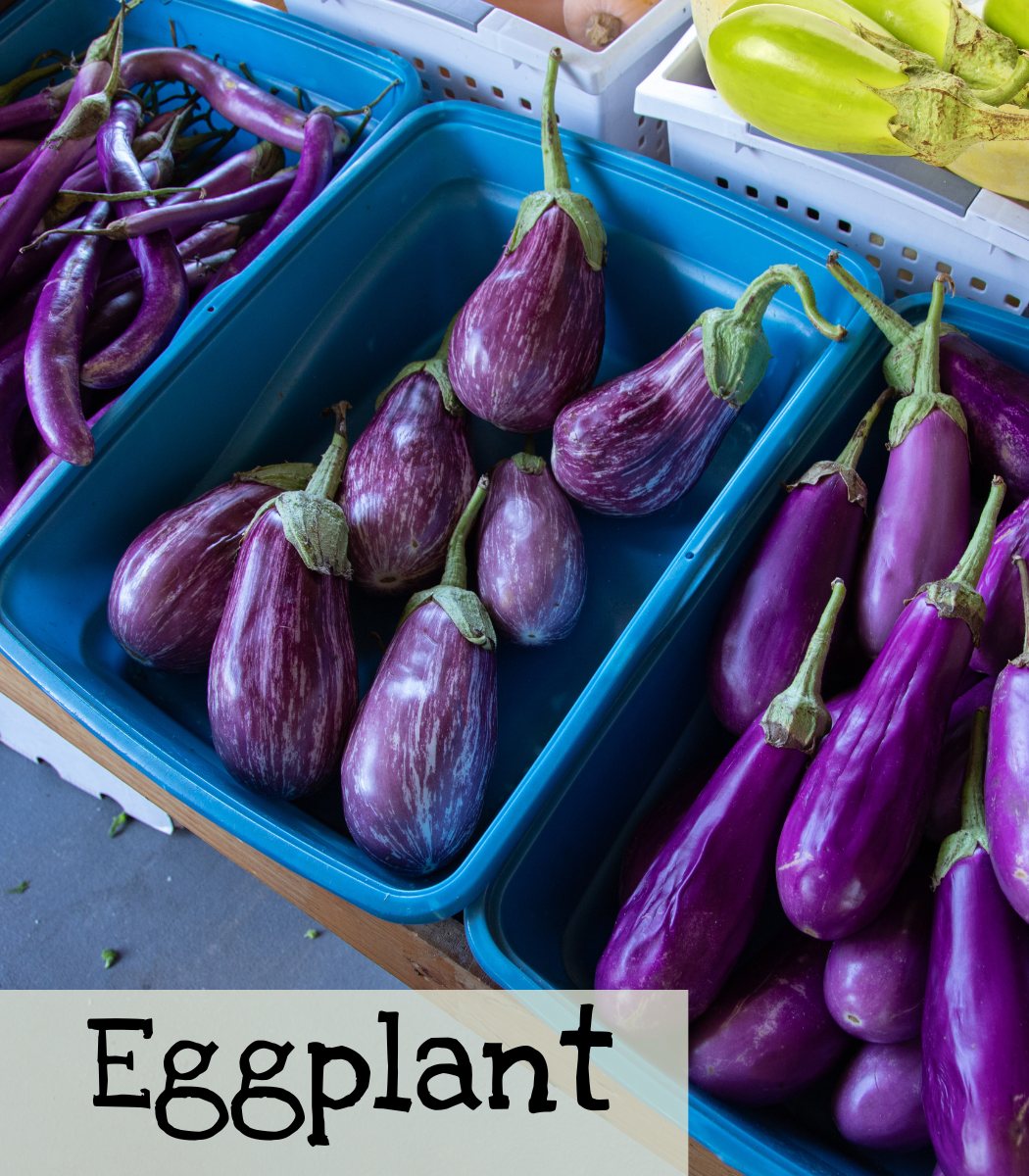
Eggplant
Eggplant is a member of the nightshade family. It is often used as a meat substitute. It can be steamed, broiled, cooked in pasta, and so much more!
|
Black Beauty; Listada De Gandia; Nagaoka Kinghaku; Melanzane Rossa Di Rotonda; Saitama Ao Daimaru; Shiromaru; Shooting Star; Thai Lavender Frog Egg; Thai Long Green |
|
Solanum melongena |
|
Intermediate to Easy |
|
Difficult |
|
5 years if properly cleaned and stored |
|
Annual |
|
10-15 days |
|
None |
|
1/4 inch |
|
|
|
Full sun |
|
|
|
February, March, April, and May |
|
Yes |

Growing Tips


When to Start
Spring: Start indoors 8-10 weeks before the last frost date and soil temperatures have warmed to at least 75 F. (Mid-Feb – Mid-Mar for Jefferson, GA)
Transplant: After all danger of frost has passed and soil temperatures have warmed to at least 75 F. (The 2nd to 3rd week of May for Jefferson, GA)
Fall: Start indoors or direct sow through late spring into early summer. Transplant July 10-30 (GA)
How to Start
Starting eggplant from seed is a bit of a challenge. When starting from seeds, the soil needs to be between 75-85 F. Use a heating mat if necessary. Eggplant is a slow germinator, it can take 2-3 weeks to germinate. Use sterile, pre-moistened seed starting mix. Sow into cells or pots to a depth of ¼ inch. Then place on a heat mat and under grow lights. Harden off before transplanting. Transplants can go out in the garden once temperatures stay reliably above 50 F.
For direct sowing, sow seeds to a depth of ¼ of an inch. Sow into full sun and fertile, well-draining soil. Thin seedlings so they are 2 to 3 inches apart. Space plants 18 inches from each other and in rows that are 36 inches apart.
Care
Eggplant grows during short, hot seasons, so be aware of soil and air temperatures as you plan how and when to get eggplants started.
Eggplants do best when the soil is consistently moist. Water regularly, especially when the plants are young so that they develop deep roots. Avoid overhead watering to prevent disease, but consider using mulch to keep the soil moist, and warm, and to keep weeds down.
Harvest
Don’t let eggplants stay on the plant past maturity (Unless you are letting it go to seed). They will not retain their quality. To harvest eggplants, wait until the fruit is glossy. Use shears or scissors. If you try to pull them off, you will most likely damage the plant, the fruit, or both. Eggplants have a short shelf life. You can store them for about a week in the refrigerator.
Seed Saving

Isolation Distance
Eggplant varieties should be separated by 1/2 mile.
Instructions
Eggplants should be left on the plants until well past the eating stage before harvesting for seed. The eggplants will have gone past their normal, ripe color and become translucent and dry (usually a dull, unattractive whitish, yellowish, or brownish color).
To clean wet seeds, scoop the seeds from the fruit, pulp, and all. Pour the seeds and pulp into a large, sloping bowl and add water. Healthy seeds will sink to the bottom of the bowl, while dead seeds and most of the pulp will float. Use your fingers to gently separate all the seeds from the pulp. Let cleaned seeds fully dry.
- Black Beauty: Heirloom. Ripens early (74 days). The purple fruit can get large.
- Listada De Gandia: An heirloom from Spain. Seven-inch purple and white striped teardrop-shaped fruit.
- Melanzane Rossa Di Rotonda: Heirloom. A red eggplant that is oblate and smooth.
- Nagaoka Kinghaku: A dark obsidian eggplant from Japan. It is an heirloom variety that is known to be among the sweetest and is traditionally steamed with a bit of ginger and soy sauce.
- Saitama Ao Daimaru: Heirloom. An apple-green eggplant that has a dense and creamy texture. It is globe-shaped with a flat bottom.
- Shiromaru: Heirloom. A Japanese eggplant with green skin. Ideal for grilling or even eating raw with a sprinkle of salt. The skin is firm, but the flesh is mild, sweet, and creamy with no bitterness. This variety is exceptionally heat-tolerant.
- Shooting Stars: A good variety for containers due to its compact size. It has 3-4 inch long fruit.
- Thai Lavender Frog Egg: A Thai heirloom that produces cherry tomato-sized fruit. High-yielding.
- Thai Long Green: A Thai heirloom that is mild and sweet. Fruit is 10-12” long and lime green.

- Eggplant is only intermediate because is harder to start from seed.
- It’s a good idea to keep eggplants off the ground during the seed ripening process, since they may begin to rot when they rest on the ground.
Sources:
Starting & Saving Seeds By Julie Thompson-Adolf
